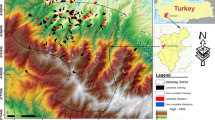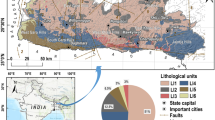Abstract
Landslide susceptibility assessment was adopted for the Idukki region using 6 machine learning models viz., Adaptive Boosting (AdaBoost), Naïve Bayes (NB), Neural Network (NNET), Random Forest (RF), Support Vector Machine (SVM) and eXtreme Gradient Boosting (XGBoost) models. Due to the severe calamity caused by landslides in the Idukki district during the August 2018 monsoon, the district was listed as one of the top hotspots for landslides, which is why this study focuses on them. Eighteen conditioning factors that influenced the occurrence of the landslides in the Idukki region were considered primarily in this study. However, the Recursive Feature Elimination (RFE) approach was adopted to eliminate the variables with low importance. The research focuses on the sensitivity of the causative factors and explores the conditioning parameters that are considered necessary by each machine learning algorithm. Furthermore, the Accuracy, Kappa index, ROC-AUC, Sensitivity, Specificity were computed to estimate the performance of the models. The RF model portrayed the best prediction accuracy in training and testing cases, followed by the AdaBoost and XGBoost models. However, while determining the consistency of the model based on its practical applicability by generating the landslide susceptibility maps, the AdaBoost and NNET model showed better consistency, and the XGBoost model displayed inconsistency. Thus, the AdaBoost model was the best in accuracy and practical consistency compared to the other five models.



















Similar content being viewed by others
Availability of data and materials
The data that support the findings of this study are available on request from the corresponding author, [Jesudasan Jacinth Jennifer].
References
Abedini M, Tulabi S (2018) Assessing LNRF, FR, and AHP models in landslide susceptibility mapping index: a comparative study of Nojian watershed in Lorestan province. Iran Environ Earth Sci 77:1–13. https://doi.org/10.1007/s12665-018-7524-1
Abraham MT, Pothuraju D, Satyam N (2019) Rainfall thresholds for prediction of landslides in Idukki, India: An empirical approach. Water 11:1–16. https://doi.org/10.3390/w11102113
An K, Kim S, Chae T, Park D (2018) Developing an accessible landslide susceptibility model using open-source resources. Sustainability 10:1–13. https://doi.org/10.3390/su10020293
Bergstra J, Yamins D, Cox DD (2013) Making a science of model search: hyperparameter optimization in hundreds of dimensions for vision architectures. In: 30th International Conference on Machine Learning. p 9
Breiman L (1996) Bagging Predictors. Mach Learn 24:123–140. https://doi.org/10.3390/risks8030083
Bui DT, Pradhan B, Revhaug I et al (2015) A novel hybrid evidential belief function-based fuzzy logic model in spatial prediction of rainfall-induced shallow landslides in the Lang Son city area (Vietnam). Geomat Nat Hazards Risk 6:243–271. https://doi.org/10.1080/19475705.2013.843206
Bzdok D, Altman N, Krzywinski M (2018) Points of significance: statistics versus machine learning. Nat Methods 15:233–234. https://doi.org/10.1038/nmeth.4642
Campiglio E, Dafermos Y, Monnin P et al (2018) Climate change challenges for central banks and financial regulators. Nat Clim Chang 8:462–468. https://doi.org/10.1038/s41558-018-0175-0
Caniani D, Pascale S, Sdao F, Sole A (2008) Neural networks and landslide susceptibility: a case study of the urban area of potenza. Nat Hazards 45:55–72. https://doi.org/10.1007/s11069-007-9169-3
Chandra S, Indrajit P (2019) GIS - based spatial prediction of landslide susceptibility using frequency ratio model of Lachung river basin, North Sikkim, India. SN Appl Sci 1:1–25. https://doi.org/10.1007/s42452-019-0422-7
Chen T, Guestrin C (2016) XGBoost: a scalable tree boosting system. in: proceedings of the 22nd ACM SIGKDD International Conference on Knowledge Discovery and Data Mining - KDD ’16. p 665
Colesanti C, Wasowski J, Wasowski J (2006) Investigating landslides with space-borne synthetic aperture radar (SAR) interferometry. Eng Geol. https://doi.org/10.1016/j.enggeo.2006.09.013
Cortes C, Vapnik V (1995) Support-vector networks. Mach Learn 20:273–297. https://doi.org/10.1109/64.163674
Dai FC, Lee CF (2002) Landslide characteristics and slope instability modeling using GIS, Lantau Island, Hong Kong. Geomorphology 42:213–228. https://doi.org/10.1016/S0169-555X(01)00087-3
Di Napoli M, Carotenuto F, Cevasco A et al (2020) Machine learning ensemble modelling as a tool to improve landslide susceptibility mapping reliability. Landslides 17:1897–1914. https://doi.org/10.1007/s10346-020-01392-9
Diffenbaugh NS, Field CB (2013) Changes in ecologically critical terrestrial climate conditions. Science 341:486–492. https://doi.org/10.1126/science.1237123
Dou J, Yunus AP, Tien Bui D et al (2019) Evaluating GIS-based multiple statistical models and data mining for earthquake and rainfall-induced landslide susceptibility using the LiDAR DEM. Remote Sens 11:638. https://doi.org/10.3390/rs11060638
Ercanoglu M, Gokceoglu C (2002) Assessment of landslide susceptibility for a landslide-prone area (north of Yenice, NW Turkey) by fuzzy approach. Environ Geol 41:720–730. https://doi.org/10.1007/s00254-001-0454-2
French MN, Krajewski WF, Cuykendall RR (1992) Rainfall forecasting in space and time using a neural network. J Hydrol 137:1–31. https://doi.org/10.1016/0022-1694(92)90046-X
Freund Y, Schapire RE (1995) A decision-theoretic generalization of on-line learning and an application to boosting. Proc Second Eur Conf Comput Learn Theory 904:23–37. https://doi.org/10.1007/3-540-59119-2_166
Freund Y, Schapire RE (1997) A Decision-theoretic generalization of on-line learning and an application to boosting. J Comput Syst Sci 55:119–139. https://doi.org/10.1145/2818346.2823306
Garcia-Chevesich P, Wei X, Ticona J et al (2021) The impact of agricultural irrigation on landslide triggering: a review from chinese, english, and Spanish literature. Water 13:1–17. https://doi.org/10.3390/w13010010
Gessesse AA, Melesse AM (2019) Temporal relationships between time series CHIRPS-rainfall estimation and eMODIS-NDVI satellite images in Amhara Region. Elsevier Inc, Ethiopia
International Federation of Red Cross and Red Crescent Societies (2001) World Disasters Report 2001: Focus on Recovery
Intrieri E, Raspini F, Fumagalli A et al (2018) The Maoxian landslide as seen from space: detecting precursors of failure with Sentinel-1 data. Landslides 15:123–133. https://doi.org/10.1007/s10346-017-0915-7
Iverson RM, Major JJ (1986) Groundwater seepage vectors and the potential for hillslope failure and debris flow mobilization. Water Resour Res 22:1543–1548
Jacinth Jennifer J, Saravanan S (2020) Contribution of SAR-driven displacement measurement in assessing the triggering factors of rainfall-induced landslides. Geocarto Int 37:1514
James G, Witten D, Hastie T, Tibshirani R (2013) An introduction to statistical learning, 1st edn. Springer Verlag New York, New York
Janardhana MR, Vinutha DN, Al-qadhi AA (2016) Landslides in Coorg District of Karnataka State. Int J Innovat Res Sci Eng Technol 5(6):10120–10125. https://doi.org/10.15680/IJIRSET.2015.0506112
Jennifer JJ, Saravanan S (2020) Contribution of SAR-driven displacement measurement in assessing the triggering factors of rainfall-induced landslides. Geocarto Int. https://doi.org/10.1080/10106049.2020.1844313
Jennifer JJ, Saravanan S (2021) Artificial neural network and sensitivity analysis in the landslide susceptibility mapping of Idukki district, India. Geocarto Int. https://doi.org/10.1080/10106049.2021.1923831
Jennifer JJ, Saravanan S, Abijith D (2020a) Integration of SAR and multi-spectral imagery in flood inundation mapping–a case study on Kerala floods 2018. ISH J Hydraul Eng. https://doi.org/10.1080/09715010.2020.1791265
Jennifer JJ, Saravanan S, Pradhan B (2020b) Persistent scatterer interferometry in the post-event monitoring of the Idukki landslides. Geocarto Int. https://doi.org/10.1080/10106049.2020.1778101
Jibson RW, Harp EL, Michael JA (2000) A method for producing digital probabilistic seismic landslide hazard maps. Eng Geol 58:271–289. https://doi.org/10.1016/S0013-7952(00)00039-9
Jones S, Kasthurba AK, Anjana B, Binoy BV (2021) Landslide susceptibility investigation for Idukki district of Kerala using regression analysis and machine learning. Arabian 14:17
Kanevski M, Pozdnoukhov A, Timonin V (2009) Machine learning for spatial environmental data first. CRC Press, Taylor & Francis Group, Boca Raton
Kanungo DP, Singh R, Dash RK (2020) Field observations and lessons learnt from the 2018 landslide disasters in Idukki district, Kerala. Curr Sci 119:1797–1806
Kearns M, Valiant L (1994) Cryptographic limitations on learning boolean formulae and finite automata. J ACM 41(1):67–95. https://doi.org/10.1145/174644.174647
Kuriakose SL (2010) Physically-based dynamic modelling of the effect of land use changes on shallow landslide initiation in the Western Ghats of Kerala. University of Twente, India
Kuriakose SL, Sankar G, Muraleedharan C (2009) History of landslide susceptibility and a chorology of landslide-prone areas in the Western Ghats of Kerala, India. Environ Geol 57:1553–1568. https://doi.org/10.1007/s00254-008-1431-9
Landis JR, Koch GG (1977) An application of hierarchical kappa-type statistics in the assessment of majority agreement among multiple observer. Biometrics 33:363–374
Lee S, Pradhan B (2006) Probabilistic landslide hazards and risk mapping on Penang island, Malaysia. J Earth Syst Sci 115:661–672. https://doi.org/10.1007/s12040-006-0004-0
Lee S, Choi J, Min K (2004) Probabilistic landslide hazard mapping using GIS and remote sensing data at Boun, Korea. Int J Remote Sens 25:2037–2052. https://doi.org/10.1080/01431160310001618734
Lopresti A, Charland A, Woodard D et al (2015) Rate and velocity of climate change caused by cumulative carbon emissions. Environ Res Lett 10:95001. https://doi.org/10.1088/1748-9326/10/9/095001
Luigi S, Guzzetti F (2016) Earth-science reviews landslides in a changing climate. Earth Sci Rev 162:227–252. https://doi.org/10.1016/j.earscirev.2016.08.011
Marjanović M, Kovačević M, Bajat B, Voženílek V (2011) Landslide susceptibility assessment using SVM machine learning algorithm. Eng Geol 123:225–234. https://doi.org/10.1016/j.enggeo.2011.09.006
Martha TR, Saha R, Kumar KV (2012) Synergetic use of satellite image and DEM for identification of landforms in a ridge-valley topography. Int J Geosci 03:480–489. https://doi.org/10.4236/ijg.2012.33051
Meisina C, Zucca F, Fossati D, et al (2006) PS InSAR integrated with geotechnical GIS: Some Examples from Southern Lombardia. In: International Association of Geodesy Symposia
Merghadi A, Yunus AP, Dou J et al (2020) Machine learning methods for landslide susceptibility studies: a comparative overview of algorithm performance. Earth-Science Rev 207:103225. https://doi.org/10.1016/j.earscirev.2020.103225
Mersha T, Meten M (2020) GIS-based landslide susceptibility mapping and assessment using bivariate statistical methods in Simada area, northwestern Ethiopia. Geoenviron Dis. https://doi.org/10.1186/s40677-020-00155-x
Moresi FV, Maesano M, Collalti A et al (2020) Mapping landslide prediction through a GIS-based model : a case study in a catchment in Southern Italy. Geosciences 10:22
Pascale S, Parisi S, Mancini A et al (2013) Landslide Susceptibility mapping using artificial neural network in the urban area of Senise and San Costantino Albanese (Basilicata, Southern Italy). In: Murgante B et al (eds) Computational science and its applications lecture notes in computer science ICCSA 2013. ICCSA 2013. Lecture notes in computer science. Springer, Berlin, Heidelberg
Rabby YW, Hossain MB, Abedin J (2020) Landslide susceptibility mapping in three Upazilas of Rangamati hill district Bangladesh: application and comparison of GIS-based machine learning methods. Geocarto Int. https://doi.org/10.1080/10106049.2020.1864026
Rahardjo H, Li XW, Toll DG, Leong EC (2001) The effect of antecedent rainfall on slope stability. Geotech Geol Eng 19:371–399. https://doi.org/10.1023/A:1013129725263
Ramasamy S, Gunasekaran S, Saravanavel J, Joshua RM, Rajaperumal R, Kathiravan R, Palanivel K, Muthukumar M (2020) Geomorphology and landslide proneness of Kerala, India a geospatial study. Landslides. https://doi.org/10.1007/s10346-020-01562-9
Ramesh V, Mani S, Baskar M et al (2017) Landslide hazard zonation mapping and cut slope stability analyses along Yercaud ghat road (Kuppanur–Yercaud) section, Tamil Nadu. India Int J Geo-Eng. https://doi.org/10.1186/s40703-017-0039-x
Reichenbach P, Rossi M, Malamud BD et al (2018) A review of statistically-based landslide susceptibility models. Earth-Science Rev 180:60–91. https://doi.org/10.1016/j.earscirev.2018.03.001
Rickli C, Graf F (2009) Effects of forests on shallow landslides—case studies in Switzerland. For Snow Landsc Res 82:33–44
Sdao F, Lioi DS, Pascale S et al (2013) Landslide susceptibility assessment by using a neuro-fuzzy model: a case study in the Rupestrian heritage rich area of Matera. Nat Hazards Earth Syst Sci 13:395–407. https://doi.org/10.5194/nhess-13-395-2013
Su Q, Zhang J, Zhao S et al (2017) Comparative assessment of three nonlinear approaches for landslide susceptibility mapping in a coal mine area. ISPRS Int J Geo Inform 6:1–17. https://doi.org/10.3390/ijgi6070228
Wang R (2012) AdaBoost for feature selection, classification and its relation with SVM, a review. Phys Procedia 25:800–807. https://doi.org/10.1016/j.phpro.2012.03.160
Zeng-wang X (2001) GIS and ANN model for landslide susceptibility mapping. J Geogr Sci 11:374–381. https://doi.org/10.1007/bf02892323
Zhang H, Su J (2004) Naive Bayesian classifiers for ranking. Lecture Notes in Artificial Intelligence (Subseries of Lecture Notes in Computer Science). Springer, Berlin Heidelberg, pp 501–512
Zweig MH, Campbell G (1993) Receiver-operating characteristic (ROC) plots: a fundamental evaluation tool in clinical medicine. Clin Chem 39:561–577. https://doi.org/10.1093/clinchem/39.4.561
Funding
The author declare that no funds, grants, or other support were received during the preparation of this manuscript. The author has no relevant financial or non-financial interests to disclose.
Author information
Authors and Affiliations
Corresponding author
Additional information
Publisher's Note
Springer Nature remains neutral with regard to jurisdictional claims in published maps and institutional affiliations.
Rights and permissions
Springer Nature or its licensor holds exclusive rights to this article under a publishing agreement with the author(s) or other rightsholder(s); author self-archiving of the accepted manuscript version of this article is solely governed by the terms of such publishing agreement and applicable law.
About this article
Cite this article
Jennifer, J.J. Feature elimination and comparison of machine learning algorithms in landslide susceptibility mapping. Environ Earth Sci 81, 489 (2022). https://doi.org/10.1007/s12665-022-10620-5
Received:
Accepted:
Published:
DOI: https://doi.org/10.1007/s12665-022-10620-5




